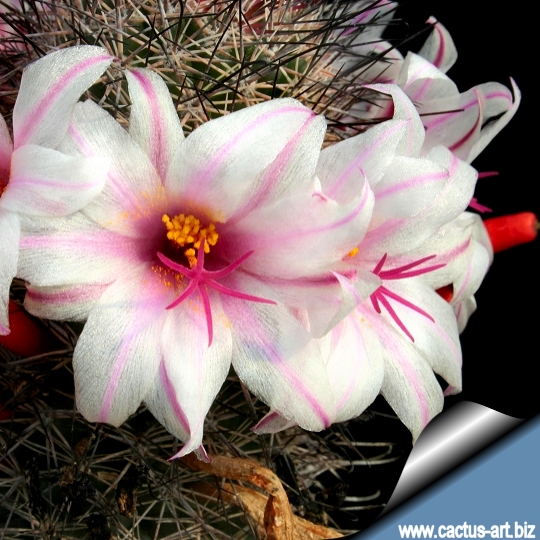|
|
|

Mammillaria fraileana SB1247 Pichilingue BCS.
Slowly
offsetting, thin upright dark green stems, 3-4 cm in diameter, up to 15 cm
tall.
|
 |
 |
|
|
|
|

The so-called
"yellow form" with yellowish-green stigma lobes. |

It starts flowering when still very small.
Best for
full sun to
light shadow. |

Roots are fibrous but moderately swollen. |

Dark purplish spines with a
hooked
central one. |
|
|
|
Photo of conspecific taxa, varieties, forms and
cultivars of Mammillaria fraileana.
|
|


Advertising
|
|
|
|
|
Family:
Cactaceae (Cactus
Family)
Scientific name: Mammillaria
fraileana (Britt. & Rose) Boed. 1933
First description by Britton & Rose 1923, Neomammillaria
fraileana.
Origin:
Mexico, state of Baja California (on the Coast of Gulf of
California, near La Paz, Cabo san Lucas, Todos santos)
Habitat: Grows in non calcareous rocks.
Conservation status: Listed in
CITES appendix 2.
Synonyms:
- Bartschella albicans ssp. fraileana (Britton & Rose)
D.R. Hunt 1997
- Chilita fraileana (Britton & Rose) Orcutt 1926
- Ebnerella fraileana (Britton & Rose) Buxbaum
1951
- Neomammillaria fraileana
- Mammillaria albicans ssp. fraileana
- Mammillaria albicans
|
|
|
Description: Slowly
offsetting, irregularly forming small clusters.
Stem: Cylindrical, narrow, eventually clumping near the base of the
plant, without latex, 3-4 cm in diameter, 15 cm tall. Body
is green, but often
reddish if grown in full light.
Tubercles: Pyramidal without latex, axil naked (or with a few
bristles)
Roots: Fibrous or moderately swollen..
Radial spine: 11 to 12, 8 to 10 mm long, thin and white.
Central spine: 3 to 4, 10 mm long, dark brown, with one central
spine, hooked.
Flowers: Light pink flower, petals with darker pink median line, 2,5-3
cm in diameter, stigma bright carmine-pink. (A form with greenish-yellow
stigma lobes is also known as "yellow form" )
Fruit: Red, clavate and long lasting on the plant.
Seed: Black.
Blooming season (Europe): From May to September.
|
|

Gorgeous flowers and very decorative,
long-lasting red
fruits. |
|

Light pink flower, petals with a darker
median line, 3 cm in diameter. Unusual pink
stigma stretched out towards the sun. |
|
Cultivation: This plant
isn't famous
for being easy to cultivate, but in good conditions
with excellent
ventilation,
it grows without difficulty. It is especially sensitive to over-watering.
So careful watering and an open
mineral
potting soil are a must.
Avoid
the use of
peat or other
humus sources in the
potting mixture.
Don't add
limestone
to the potting mix, which must be moderately acidic.
Can be sensitive to frost (but some populations are resistant to
-10° C). Requires
maximum
sun exposure
to reach its full potential.
and in order to
achieve success in
flowering.
A winter rest that allows the plant to shrivel (perhaps losing up to
25% of its summer height) will encourage flowering and long
term
survival. Be careful to encourage slow growth.
Propagation: Seeds or
offsets. |
|